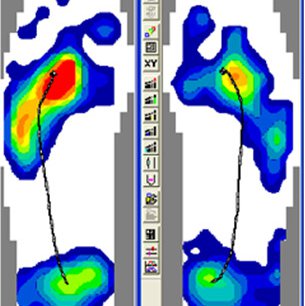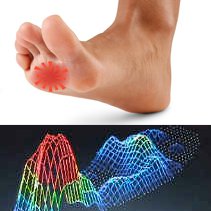Forefoot pain
Forefoot pain (often referred to as metatarsalgia), can have many causes. The key is to make an accurate diagnosis and to ascertain the cause for the condition. In most cases a diagnosis can be made using our on site high resolution ultrasound machines whilst gait analysis will often show the cause for the condition. The Centre uses different treatment techniques including orthotic therapy, joint mobilisation, rehabilitation, injection therapy and surgery to treat forefoot pain. Kinetic analysis (pressure/force analysis) is one of the key investigations used at the Centre to determine the cause for metatarsalgia. In many cases, when the pressures are normalised by treatment, symptoms will improve.
Causes for metatarsalgia include:
- Morton's neuroma: A condition where the nerve becomes impinged and thickened. If the nerve has not enlarged too much, then non-surgical treatment can be effective. In cases where the nerve is large, injection therapy or surgery may be required. For more information on Morton's neuroma, see our sister site.
- Plantar Plate / Flexor Tendon Inflamation: This is probably the most common cause for forefoot pain. Here the metatarsal heads have become over loaded due to foot instability and excessive pressure. Non-surgical treatment is generally effective unless the condition has become very chronic or the tissues have torn. Our Centre uses various corrective surgical techniques to repair the tissues.
- Stress fractures: These are often seen at the centre and must be diagnosed and managed quickly to avoid a "complete fracture" which can have far more serious consequences. The problem is generally caused by metatarsal overload which can be managed with specialised orthoses (shoe inserts) and shoe change. We would carefully consider and treatment other risk factors such as poor training technique, abnormal bone density and equipment / shoe issues.
- Freiberg's Infarction. Here the metatarsal head begins to break down due to compromised circulation, often following a stubbing injury. The Centre offers various treatments ranging from orthoses to a range of advanced surgical techniques.
Some of the surgical techniques offered at our Centre to manage forefoot pain include
1) Minimally invasive cryosurgery: Please see our specialist web site on cryosurgery which we particularly use for a condition called Morton's neuroma. We do however use this for other types of nerve condition of the forefoot.
2) Ablative radiofrequency: This is a technique which involves the application of heat via a fine needle. It can be used to destroy discrete areas of abnormal tissue in the foot. It is particularly effective in breaking down bursitis which is a common condition in the forefoot. Bursitis occurs when a small bag of fluid that forms inside the body ( a bursa) becomes inflamed.
3) Pulses radiofrequency: is a technique used to treat over sensitive nerves which can cause forefoot pain. it is particularly low risk procedure. There is minimal pain associated with this procedure and patient can return to their usual activity almost immediately.
4) Hydro-dissection: This is a technique that uses high pressure water and or anaesthetic to break down scar tissue in the foot. It is often used successfully at our Centre to treat a range of forefoot conditions
5) Minimally invasive surgery: In some cases a small incision can be made to release bound down tissue or tight tendons to manage forefoot pain. Our Centre specialises in minimally invasive techniques
6) Open surgery: In some cases open surgery is required to repair tissues so as to allow for recovery and normal foot function. Our Centre uses a diverse range of open techniques to manage many types of forefoot condition. In some cases direct repair of the torn tissue is required. Where forefoot arthritis is present, the arthritic bone is removed to allow for recovery. When the arthritis is too advanced we may perform an interposition arthroplasty which involves using a patients own tissue to create a natural "spacer" for the joint so that it can function more normally. This is a technique that has been refined and developed at our Centre and this can be very successful for great toe joint pain.
The below image shows why one of our patients has developed left forefoot pain as the pressures are clearly very elevated. Unless gait is changed to reduce the pressures, symptoms are likely to persist.



